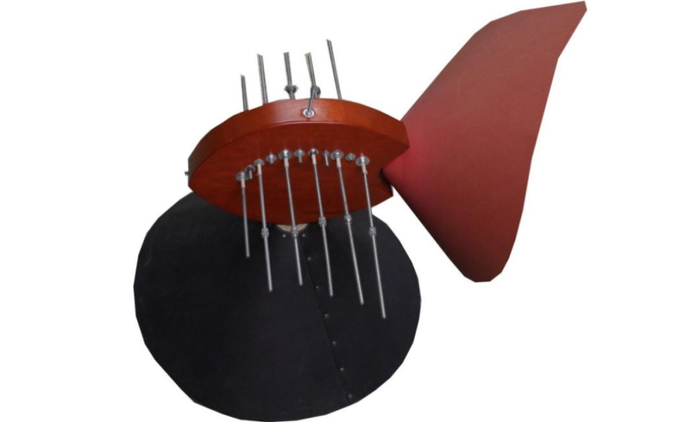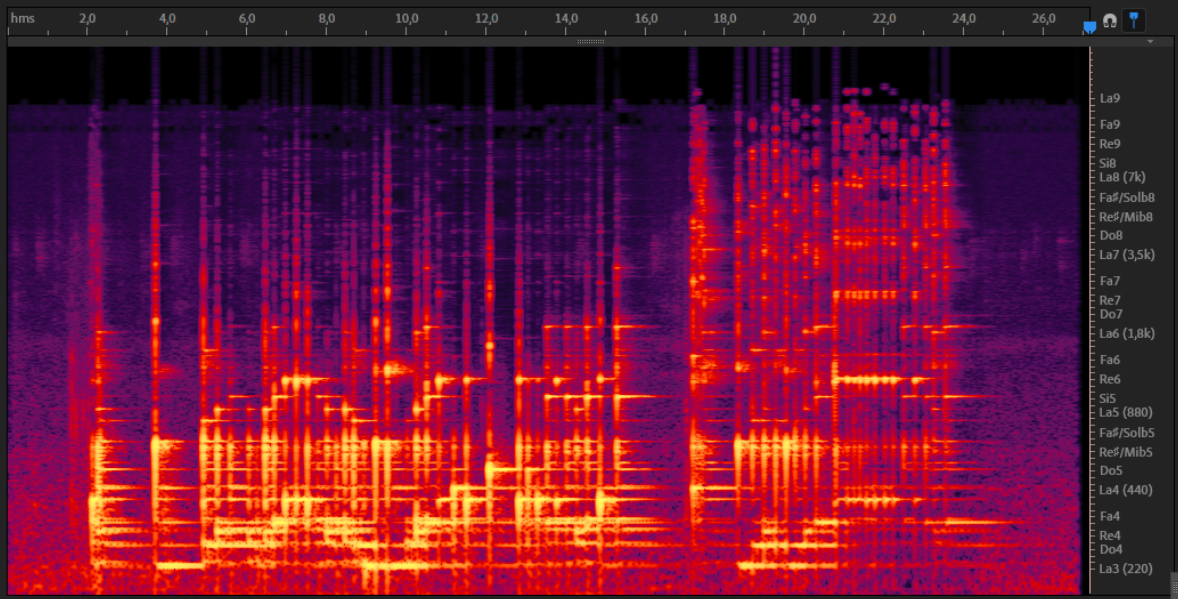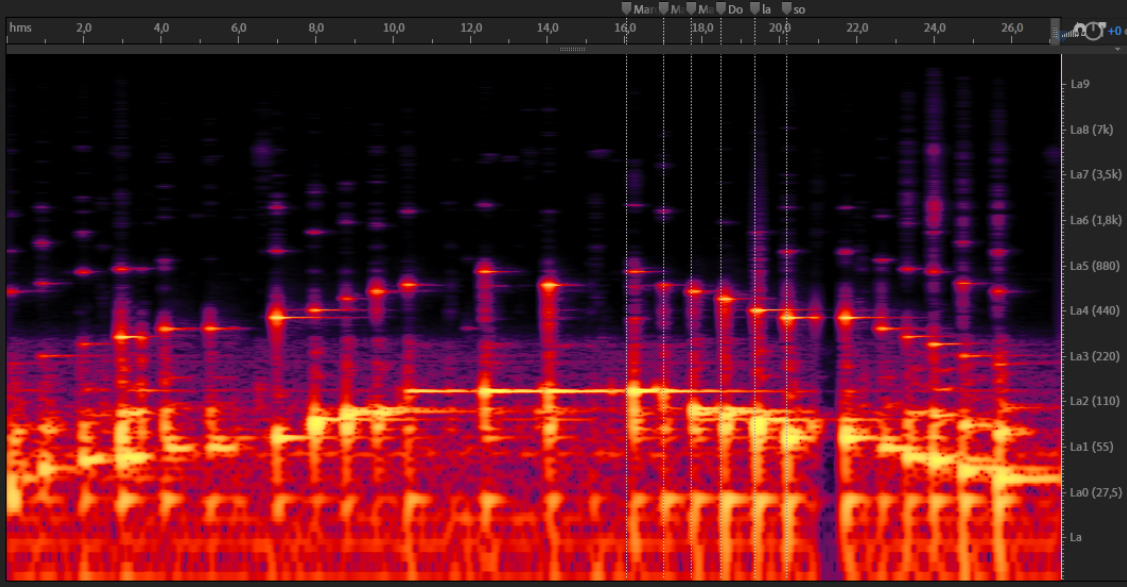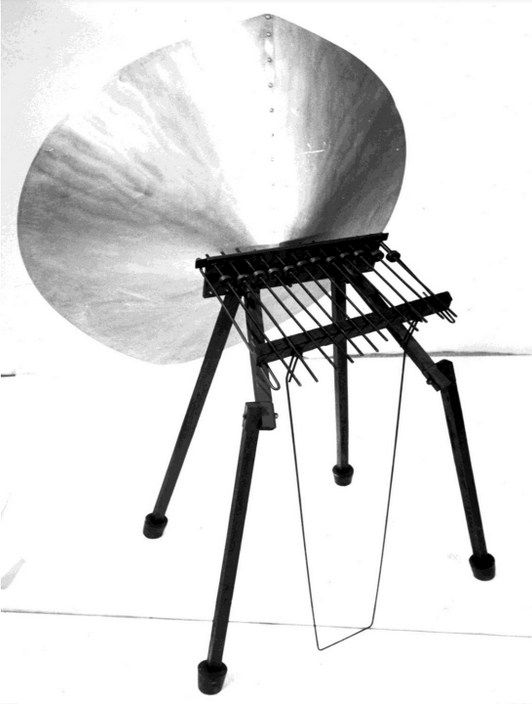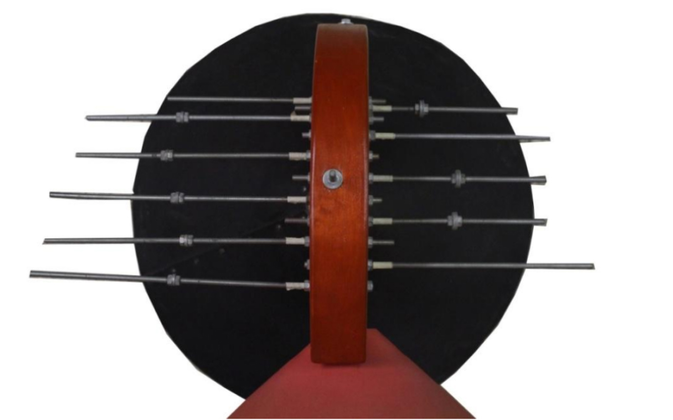Threaded Rods with Weights Along Their Lengths
Instead of removing mass from certain regions as usually done to retune kalimba tines, the Baschets added weights for the same purpose. The weights, made with washers, can appear anywhere along the length of a rod, placed to alter the natural vibrational modes and retune some of the overtones by changing their natural ratios. These weights add more inertia to the amplitude of an antinodal region, or move the antinodal region along the rod’s length changing the wavelength of a specific overtone or the fundamental.
This allows for a modular process of trial and error, without welding or other destructive techniques, since this method of overtone tuning is usually a very complex empirical endeavour. This is one of the great benefits of working with threaded rods and not smooth round rods. The amount of weight and the shape can be very relevant. The studies of this technical approach to redefine the spectrum of a rod still have a long way to go.
Unfortunately there are many original Baschet pieces that have gone missing, of which we only have a picture or a drawing. These files from the Baschets personal archives are the proof of a great many combinations of shapes and materials, but even after having studied the Baschet work for a decade, we don’t have much information about their tuning or timbral features. Nonetheless we have an intuitive sense of the overall sonority, and we can create replicas as accurately as possible to have a better sense of how these pieces would have sounded.
In this exposition we have offered as much empirical data as possible to help the reader understand and enjoy each of the Baschet odontophone mounting systems. We can find examples of this mounting system (clamped threaded rods with weights along their length) in the Multitimbral Settings examples, so there are chances to listen to this setting, but we cannot provide audio files for an original Baschet piece based entirely in this configuration. Nonetheless, we believe it is relevant to know that there were such pieces and this is why we have presented the next mute example before moving on to an après-Baschet piece based upon this system that we can listen to.
This medium size sound sculpture, built around 1960, shows weights formed by round washers tightened with nuts to relatively thin rods, near the base of the rods. There is a particular feature that appears remarkable at first glance: a dampening device formed by a bar of spongy material placed across the free ends of the rods operated by a simple foot lever. This “muffler” can be applied to stop the vibrations of the rods (partially or completely). This is an example of the ingenuity of the Baschets, present in many of the missing pieces, ready to be rediscovered.
The decreasing lengths of the rods suggests that the entire range of that oscillating system should have spanned approximately an octave. It is relatively clear to us that a specific, recognizable tuning was carefully defined and that these sound sculptures were suitable to play melodies within that pitch range.
We have also dealt with these weight settings on the DIY kits with pre-drilled gums from François’ personal collection left to our workshop. Those kits showed us how we could create a cohesive timbre across diatonic and pentatonic scales, exploring the benefits of enhancing different overtone orders by placing equal lengths on different sections of the rods.
Luckily, we have files from après-Baschet pieces using weights for overtone tuning.
First Minusculòfon, après-Baschet, by Martí Ruiz, 2010
Oscillators: 7 steel threaded rods, 6mm in diameter. Some of them have weights along their lengths.
Activation: percussion with an iron rod with a felt cap.
Radiation: hard cardboard cones with fiberglass-resin core (mounting) pieces offering a clean frequency response, warm and full sound.
Gamut: pentatonic scale in A minor (A,C,D,E,G). We began to tame the overtones intuitively. We hear the first partial of the rods, as the fundamental is too low to be radiated by the radiator (speaker).
This was one of our first innovations regarding the historical Baschet work. Under the advice and supervision of François himself, and cheered by the common joy of discovery, we decided to use wood blocks as a substitute for metal plates to function as the gum and make a portable hand-held percussion. We tried to respect François’ indication that the gum and clamped elements should have an equal total weight (at least not clamping a total amount of rods heavier than the gum), and luckily it offered a mild warm sound, since the wood filters the soundwaves according to a different impedance relationship with the metal rods. Again, these timbral qualities are distinctive from the other rod sounds, so it proves that the permutation approach allows for sound discoveries and informed sound design.
Peix de Fusta (Wooden Fish), après-Baschet, 2011
Oscillator: 11 iron threaded rods, 5 mm in diameter, with small washers tightened with nuts, along its length, clamped on both sides of a linden wood block as a gum.
Activation: percussion.
Radiator: two hard vulcanized cardboard cones, one with wooden core (mounting) piece and the other with polyurethane core.
Gamut: major C pentatonic tuned to the first overtone with a lower second backing voice (not always the same rate as the “singing” pitch) created by the fundamental mode of the rods.
During the first year of learning with François Baschet we tried wood as an alternative gum material with our first series of hand held Minusculòfons (and found it to work reasonably well). For Peix de Fusta we used a larger wooden gum and implemented a pentatonic tuning.
Having mounted two cardboard cones to increase the low end and boost the warm sound, we could clearly hear the low fundamental pitches of relatively short rods below the most prominent sound from the first partial. So we intuitively tuned both sounds of each rod, so they all were tones of the same pentatonic scale. That was done by moving and tightening the weights along the length of each rod and observing how both the fundamental and the partial changed. In the end we were able to tune the prominent upper partials to the pentatonic scale, leaving the lower sounds as a background hum not perfectly tuned (not exactly an octave below but tones from the same scale) that works well in this context. Despite not having achieved a perfect tuning match, the overall experience taught us that overtone tuning (or multi-tone tuning) can be achieved with disciplined dedication. Most important for us at that time: the warm woody sound was more than sufficient for the children’s activity we intended to do with the fish sound sculpture.
